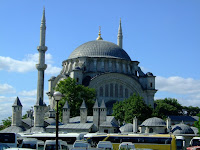 We arrived at the main bus station, some distance from the historic area of Istanbul and I set out to buy an Akbil, the Istanbul equivalent of the London Oyster Card. Finding the Akbil booth was no problem, finding out why he would not, or could not sell me one was a major problem. Even with the assistance of another Akbil customer who knew a few English words, the solution defeated us.
We arrived at the main bus station, some distance from the historic area of Istanbul and I set out to buy an Akbil, the Istanbul equivalent of the London Oyster Card. Finding the Akbil booth was no problem, finding out why he would not, or could not sell me one was a major problem. Even with the assistance of another Akbil customer who knew a few English words, the solution defeated us.Instead, we purchased tokens to ride the Metro to the end of the line then walked a while to connect with a crowded commuter tram that
 terminated a few stops before we wanted to, declined to fight our way into the next over-crowded tram and then finally made it to our destination stop. Another short walk and we were finally at our hotel having decided it would probably have been easier and quicker to have put our lives in the hands of a local taxi driver. On the other hand, half the fun is conquering foreign systems, even if you do have to pay for the Metro and the Tram when the Akbil would have allowed a free transfer.
terminated a few stops before we wanted to, declined to fight our way into the next over-crowded tram and then finally made it to our destination stop. Another short walk and we were finally at our hotel having decided it would probably have been easier and quicker to have put our lives in the hands of a local taxi driver. On the other hand, half the fun is conquering foreign systems, even if you do have to pay for the Metro and the Tram when the Akbil would have allowed a free transfer.The hotel kindly let us check in earlier than we had anticipated and it was great to freshen up before we set off to explore historic Istanbul.
 First stop was the Bascilica Cistern, an amazing underground reservoir built in the 6th century and then ‘lost’ until re-discovered in 1545. The roof is supported by 336 columns which were purloined from various ruins and thus have an array of different capitals and two have bases formed from blocks with Medusa heads carved in them. Clearly it was not intended that anyone ever saw these things under 80,000 cu m of water, but now the tourists (us included) flock to wander through and take photos of Medusa.
First stop was the Bascilica Cistern, an amazing underground reservoir built in the 6th century and then ‘lost’ until re-discovered in 1545. The roof is supported by 336 columns which were purloined from various ruins and thus have an array of different capitals and two have bases formed from blocks with Medusa heads carved in them. Clearly it was not intended that anyone ever saw these things under 80,000 cu m of water, but now the tourists (us included) flock to wander through and take photos of Medusa. One of the most iconic images of Istanbul has to be the Blue Mosque with its 6 minarets. It is dome upon dome upon semi-dome and a visual treat from the outside. Inside is where the name comes from, as much of the tile work is blue.
One of the most iconic images of Istanbul has to be the Blue Mosque with its 6 minarets. It is dome upon dome upon semi-dome and a visual treat from the outside. Inside is where the name comes from, as much of the tile work is blue.It was time to eat so we sat down to lunch at a street-side restaurant.
 After ordering we were presented with what looked like a huge pita bread that had been inflated. It is called Lavas bread, served piping hot with yoghurt based dip and is absolutely scrummy.
After ordering we were presented with what looked like a huge pita bread that had been inflated. It is called Lavas bread, served piping hot with yoghurt based dip and is absolutely scrummy.It is a pleasant stroll from the Blue Mosque through the Hippodrome to the Grand Bazaar, the largest covered bazaar in the world, with over 4000 shops, miles of streets and alleys, a mini-city within the city.
 As one would expect in any such souk in the Middle East there is plenty of hard-sell to be had from the traders attempting to sell you their wares.
As one would expect in any such souk in the Middle East there is plenty of hard-sell to be had from the traders attempting to sell you their wares.We emerged unscathed and unencumbered and returned to our hotel for another early night to catch up on our sleep.




No comments:
Post a Comment